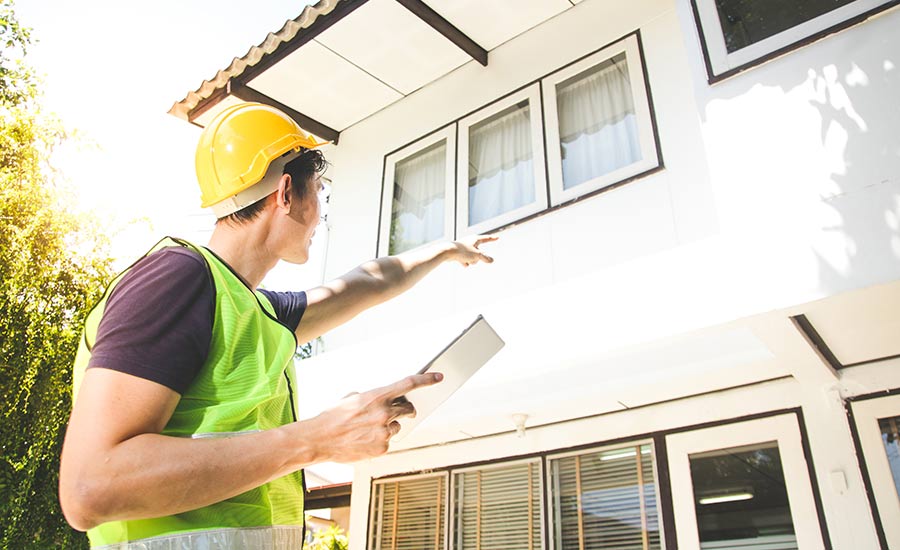
As a Federal Housing Administration (FHA) inspector, it’s important to ensure you are properly conducting and documenting each inspection. The most effective way to do this is through a detailed FHA inspection checklist.
A checklist will help you navigate the inspection process from start to finish, ensuring compliance with FHA requirements.
We’ll cover what an FHA checklist should include, provide a comprehensive template and explain how switching to digital checklists can help you improve efficiency and stay organized on the job.
Create a custom FHA inspection template.
Try doForms For Free!
What Is An FHA Inspection Checklist?
An FHA inspection checklist is a document used for the thorough examination of a property to ensure that it meets the minimum property standards set by the FHA, before an FHA loan is granted to a prospective buyer.
An FHA inspection checklist covers different home components in line with FHA requirements for:
- A sound foundation, roof and exterior
- Safe access
- Safe and functioning electrical systems
- Gas, electrical, water and sewage systems that work properly
- A functional, permanent heating system
- Easy access to the attic
- Natural ventilation in crawl areas
- Access to potable water
An FHA inspection checklist is completed by an inspector who is licensed by the U.S. Department of Housing and Urban Development (HUD) and hired by a mortgage lender.
An FHA inspection checklist serves as the basis of an FHA inspection report that:
- Determines a home’s market value
- Evaluates the appropriate loan amount for the buyer
- Identifies any serious issues with the home
- Protects buyers from investing in properties with potential problems and falling into a money pit
What Does An FHA Inspector Use A Checklist For?
An FHA inspector follows a checklist to assess both the interior and exterior of a home, ensuring all key systems are functional and the structure is free of safety hazards or major defects.
An inspector looks for:
- Electricity or plumbing problems, such as faulty wiring, outdated components or dripping pipes.
- Neighborhood or property-related issues, such as sinkholes, oil or gas wells and abandoned wells.
- Structural problems, such as damaged walls or a compromised foundation, which can be detected by water stains on walls or ceilings, or visible foundation cracks.
- Pest infestation, based on signs like rodent droppings or termite tunnels.
- Roof problems, including leaks or moisture buildup.
- Lead paint hazards, as exposure to lead can pose serious health risks, including kidney damage, reproductive issues, and high blood pressure due to lead toxicity.
- Asbestos hazards, as exposure to asbestos can lead to health issues such as lung diseases and cancer.
- Trip hazards, such as poorly installed carpeting and heaving or cracked sidewalks.
- General home safety and security issues, such as missing smoke detectors or non-functioning locks on all entry points.
- Signs of poor workmanship, such as improper plumbing or wiring.
- Accessibility issues, such as missing handrails on stairs or inadequate routes for emergency access to the house.
By considering these factors, an inspector can conclude whether the property meets the necessary FHA inspection requirements and standards for safety and livability.

During an FHA inspection, an inspector checks a home for accessibility, structural problems, pest infestation and poor workmanship
FHA Home Inspection Checklist Template
Find a sample FHA home inspection checklist below, organized by room. Feel free to modify it according to your needs:
1. Home Exterior
- Inspect the foundation for cracks, water damage and other structural issues.
- Check the roof for missing or damaged shingles that could cause water leakage.
- Check exterior walls for peeling paint, cracks or damage.
- Inspect the windows and doors to ensure proper sealing, functioning locks and no broken glass.
- Check if stairs and handrails are safe and stable.
- Inspect driveways/walkways for cracks or tripping hazards.
2. Living Room
- Check the walls and ceiling for cracks, peeling paint or moisture damage.
- Make sure flooring is even, with no loose boards or other tripping hazards.
- Confirm windows open/close easily, are properly sealed and are free of cracks.
- Test if electrical outlets are functioning properly.
- Verify that all light fixtures function properly.
- Ensure proper placement and functionality of smoke/CO2 detectors, fire sprinklers and fire alarm.
3. Bedroom
- Inspect the walls and ceilings for cracks, leaks or water damage.
- Ensure all windows have proper locking mechanisms and sealing.
- Check closets for proper shelving, doors and space usability.
- Confirm all outlets and light fixtures work properly.
- Inspect floors for tripping hazards or damage to flooring material.
4. Kitchen
- Check for leaks under the sink.
- Verify that major appliances such as the stove and refrigerator are working.
- Inspect cabinets for loose hinges and signs of wear.
- Ensure outlets are Ground Fault Circuit Interrupter (GFCI) protected and functioning.
- Make sure the ventilation is working.
5. Bathroom
- Check toilets for leaks around the base.
- Verify sink drainage and ensure there is proper water pressure.
- Inspect tubs and showers for proper drainage and water damage.
- Confirm proper ventilation to avoid moisture buildup.
- Ensure outlets are GFCI protected and working.
6. Attic & Basement
- Check foundation and support beams for cracks, water intrusion or structural concerns.
- Verify the insulation meets FHA energy standards.
- Ensure adequate ventilation to prevent moisture buildup.
- Check for exposed wiring or plumbing leaks.
7. General Health & Safety
- Test if smoke detectors are functioning properly and have fresh batteries.
- Verify that key locations like hallways near bedrooms have carbon monoxide detectors installed.
- Make sure that all stairs have handrails and non-slip treads and are in good condition.
- Check for adequate lighting along stairways to prevent accidents.
- Inspect for visible mold growth on walls, ceilings, and floors.
- Inspect for signs of pest activity such as droppings, nests or damage to property.
- Check for signs of termite activity, such as mud tubes, wood damage, or swarmers (winged termites).
- Identify any areas with potential asbestos-containing materials, such as older insulation or floor tiles.
8. Accessibility
- Ensure the property has easy access for pedestrians, emergency vehicles, and other vehicles in all weather conditions.
- Check for ramps or elevators if the home is multi-story and assess their condition and safety.
Additional Hazards & Nuisances
When inspecting for additional hazards and nuisances, check for contaminated soil, landfills and other potential dangers in the area.
The additional hazards and nuisances inspection should cover:
- Oil and gas wells on the property
- Contaminated soil
- Proximity to a hazardous waste site or landfill
- Proximity to a radio or TV transmission tower
- Proximity to high-voltage power lines
- Proximity to potential explosion sources, such as high-pressure petroleum lines or storage tanks containing flammable materials
- Proximity to ponds, pits or lagoons
- Heavy traffic
- Airport noise and hazards
- Other sources of excessive noise
- Risk of smoke and fume exposure
As you are checking each area, ensure all appliances are working correctly, check for exposed or frayed wiring, leaks, corrosion and other signs of malfunction or deterioration.

From electricity and plumbing to general health and safety, an FHA inspection checklist serves to make sure that a home passes FHA safety and livability requirements
What Happens After An FHA Inspection?
Once the FHA inspection is finalized, the FHA inspector sends a property condition report to the lender for additional review.
If the lender approves the inspection findings in terms of livability and estimated value, the loan is granted to the buyer.
If the inspector finds serious health or safety issues, such as dangerous structural problems or black mold, the lender may deny the property loan until the problem is solved.
How To Create Digital FHA Inspection Checklists With doForms
As an FHA inspector, you know that every room needs to be thoroughly checked, and that missing even a small detail and signing off on a home that is unsafe can put prospective buyers at risk — which is what makes a checklist a vital part of the job.
While paper checklists can be messy, unorganized and easily lost, doForms offers a solution — digital forms that can be created, edited, stored and sent from any device.
doForms allows you to streamline an FHA inspection by keeping all your documents and notes stored in a secure, centralized location.
Choose from an extensive library of forms or create custom mobile forms and save new templates to reuse.
With drag-and-drop features, you can quickly:
- Assemble checklists that meet all standards and requirements such as plumbing, hvac, roofing or electrical inspection checklists
- Attach photos and videos using the automatic capture feature
- Edit, save and send your documents from anywhere
Creating digital FHA inspection checklists with doForms allows you to maintain a paperless office on the go. You can use the mobile app offline, ensuring that your checklists are complete, comprehensive, and secure every time.
Build a custom FHA inspection checklist.
Try doForms For Free!
doForms Capabilities For FHA Inspectors
Whether you are an FHA inspector or supervisor, doForms capabilities extend far beyond checklists.
With doForms mobile forms solution, you can:
- Integrate a scheduling system to manage inspection visits
- Use GPS tracking capabilities to locate employees and determine their current site
- Share checklists electronically with lenders and other parties
- Access inspection reports online and offline
- Build custom charts, graphs and reports
- Secure digital signatures
- Build custom invoices
- Create employee schedules
- Manage payroll
FAQs About Digital FHA Inspection Checklists
If you’re still uncertain about the benefits of digital FHA inspection checklists, check out answers to some frequently asked questions.
How can digital checklists improve the FHA inspection process?
Digital checklists streamline the process by enabling quicker data entry, real-time updates, and easy information sharing, reducing errors and increasing efficiency.
How can inspectors access and use digital FHA checklists?
Using doForms, FHA inspectors can access digital checklists on their smartphones, tablets or laptops, allowing them to complete inspections and submit reports electronically.
How can digital checklists help with compliance challenges?
Digital checklists help maintain compliance by including fields for required criteria and ensuring they are met.




